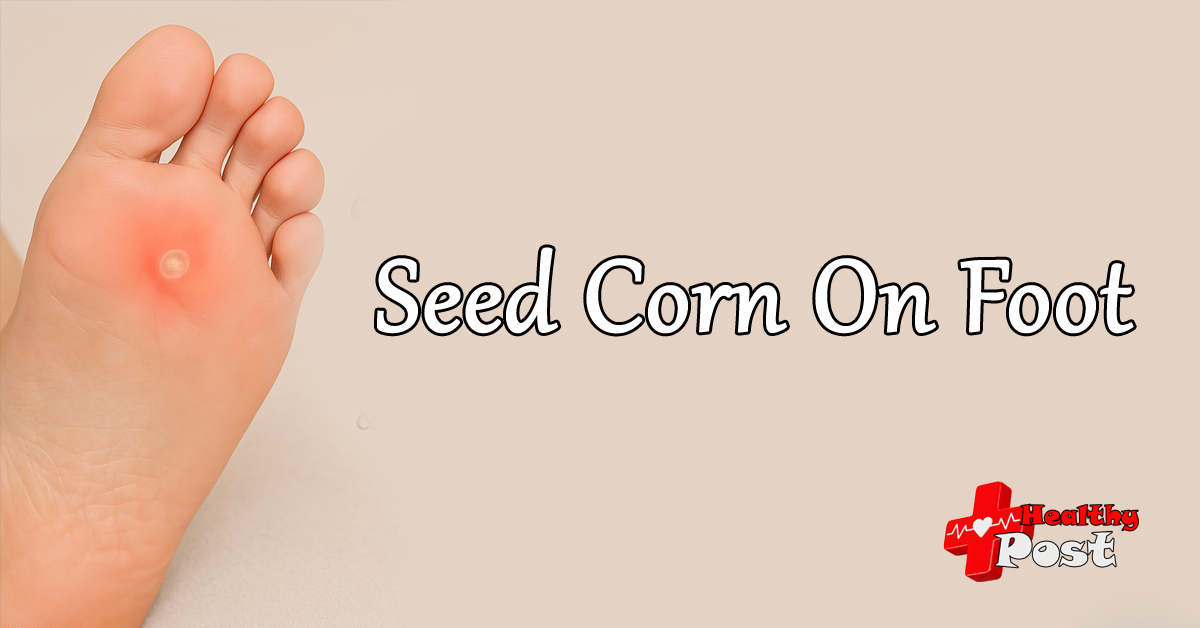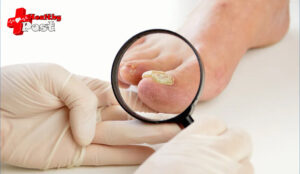
Seed Corn on Foot: Causes, Symptoms, and Effective Treatment Options
Seed corn on foot is a small, painful type of corn that appears on the sole. It usually forms on weight-bearing areas, especially the ball of the foot or heel. This condition is common and affects people who are often on their feet.
The most common cause of seed corn on foot is repeated friction or pressure. Tight shoes, walking barefoot, or foot deformities can lead to its development. Poor foot hygiene may also increase the risk. These small corns feel like hardened dots and can make walking painful.
Early signs include a tiny, rough bump and soreness in the area. The pain often increases with movement. In some cases, redness or inflammation may appear around the corn. People with dry skin are more likely to experience this condition.
Treating seed corn on foot early is very important. If ignored, the pain can worsen and affect daily activities. Timely care prevents complications like infections or skin ulcers. Home remedies, proper footwear, and medical treatments can offer quick relief.
Below is a simple comparison of common foot corns to help identify seed corn on foot:
| Type of Corn | Location | Size & Shape | Pain Level |
|---|---|---|---|
| Seed Corn | Bottom of foot | Tiny, round, hard | Moderate to high |
| Hard Corn | Top of toes | Thick, raised, hard | Moderate |
| Soft Corn | Between toes | Soft, moist, white | Low to moderate |
Understanding the basics of seed corn on foot helps in early detection and effective treatment. This article will cover all the essential facts, including its causes, symptoms, and treatment options. Taking early steps can ensure comfort and healthy feet.
What Is Seed Corn on Foot?
Seed corn on foot is a tiny, round, and hard bump that forms on the bottom of your foot. It often appears on pressure points, like the heel or ball of the foot. These corns are small but can cause a lot of discomfort when you walk or stand.
They are called “seed corns” because they look like small seeds. The center is usually hard, surrounded by slightly raised, rough skin. People with dry skin or those who walk barefoot often are more likely to get them.
How It Differs from Other Foot Calluses
Unlike regular calluses, seed corn on foot is smaller and more focused. Calluses usually cover a larger area and do not cause as much pain. Seed corns, on the other hand, press deeper into the skin and can hurt even with slight pressure.
Here’s a quick comparison:
| Feature | Seed Corn on Foot | Regular Callus |
|---|---|---|
| Size | Very small (like a seed) | Larger, flat area |
| Pain Level | Often painful | Rarely painful |
| Location | Soles, pressure points | Anywhere with friction |
| Appearance | Round, hard center | Thick, broad skin layer |
Seed corn on foot is more concentrated and painful than calluses. That’s why it needs special care and treatment.
Causes of Seed Corn on Foot
Understanding what causes seed corn on foot can help you prevent it. Several daily habits and health factors contribute to its development.
Pressure and Friction
Wearing tight shoes or high heels can create constant pressure on the feet. Walking or standing for long hours adds extra friction. Over time, this leads to the formation of seed corn on foot in high-pressure spots.
Skin Dryness
Dry skin lacks natural oils and becomes hard and rough. This dryness makes it easier for thick skin layers to form. Without moisture, your feet are more likely to develop seed corn on foot.
Foot Structure Issues
Flat feet, high arches, or uneven weight distribution can add stress to certain parts of your feet. This constant pressure increases the chance of getting seed corn on foot in those areas.
Certain Health Conditions
Conditions like diabetes or poor blood circulation reduce skin health. These issues make the feet more prone to pressure-related problems. People with these conditions are at higher risk of developing seed corn on foot.
Preventing seed corn on foot starts with understanding and avoiding these common causes. Proper foot care and supportive footwear are key.
Symptoms of Seed Corn on Foot
Recognizing the signs of seed corn on foot early can help you take action before it worsens. Here are the most common symptoms to watch for:
Hard, Round Callus
The main symptom of seed corn on foot is a small, round, and hard bump. It usually forms on the sole, especially in high-pressure areas. The bump feels firm and is often painful when touched.
Pain While Walking
Even though it’s small, seed corn on foot can cause sharp pain while walking or standing. The pain gets worse when pressure is applied to the area. This can make daily activities uncomfortable or even difficult.
Sensitive Skin
The skin around seed corn on foot may become red, irritated, or inflamed. It might feel tender or extra sensitive, especially after wearing tight shoes or standing for long periods.
If you notice these signs, it’s important to begin treatment early. Proper care can ease symptoms and prevent the condition from getting worse.

Diagnosis and When to See a Doctor for Seed Corn on Foot
Identifying seed corn on foot early can help you avoid pain and complications. Here’s how to check for it and know when to seek medical advice.
Self-Check
You can often spot seed corn on foot at home by looking for:
- A small, hard, round bump on the sole
- Pain when walking or pressing on the area
- Dry, thickened skin around the bump
- Redness or irritation nearby
If these signs match your symptoms, you may have seed corn on foot.
Medical Examination
A podiatrist can confirm seed corn on foot through a simple foot exam. They will check the location, texture, and size of the bump. They may also ask about your footwear and daily habits. In rare cases, they might take a skin sample to rule out other conditions.
When to Seek Help
See a doctor if:
- The pain gets worse or doesn’t go away
- The corn shows signs of infection (swelling, redness, or pus)
- You have diabetes or poor circulation
- Home treatments haven’t worked after two weeks
Getting professional help for seed corn on foot ensures safe and effective care. Early treatment prevents serious foot problems, especially if you have underlying health issues.
Home Remedies for Seed Corn on Foot
You can treat seed corn on foot at home with simple and effective methods. These remedies help reduce pain and prevent it from coming back.
Soaking Feet
Soak your feet in warm water for 10 to 15 minutes daily. This softens the skin and makes it easier to remove the corn. Add Epsom salt for extra relief and relaxation.
Exfoliation
After soaking, gently rub the area with a pumice stone. This removes dead skin and reduces the size of the seed corn on foot. Do not scrub too hard, as it may irritate the skin.
Moisturizing
Apply a thick moisturizer or foot cream daily. Hydrated skin is less likely to harden and form corns. Look for creams with urea or salicylic acid for better results.
Proper Footwear
Wear shoes that fit well and offer support. Avoid tight, high-heeled, or narrow shoes. Choose soft insoles or cushioned soles to reduce pressure on the seed corn on foot.
These home remedies are safe and easy to use. If your symptoms don’t improve, it’s time to consider medical treatments.

Medical Treatment Options for Seed Corn on Foot
If home care doesn’t work, medical treatments can provide fast relief from seed corn on foot. These options are safe and effective, especially for severe or recurring cases.
Salicylic Acid Products
Over-the-counter treatments with salicylic acid help soften and dissolve the hardened skin. These come in pads, gels, or creams. Apply only to the seed corn on foot, not the surrounding skin. Always follow the instructions to avoid irritation or burns.
Professional Removal
A podiatrist can safely trim or shave the seed corn on foot using sterile tools. In some cases, minor surgical procedures are done to remove deeper corns. This provides instant relief and reduces the risk of infection.
Orthopedic Inserts
Custom shoe inserts or orthotics help distribute pressure evenly across the foot. This prevents excess pressure on the same spot and reduces the chance of seed corn on foot returning. They are especially helpful for people with foot structure issues.
Medical treatments are the best choice if your corn is painful, infected, or keeps coming back. They ensure lasting relief and better foot health.
Prevention Tips for Seed Corn on Foot
Preventing seed corn on foot is easier than treating it. A few simple habits can keep your feet healthy and pain-free.
Wear Comfortable Shoes
Choose shoes that fit well and support your feet. Avoid tight or high-heeled shoes that create pressure points. A proper fit helps reduce the risk of seed corn on foot.
Use Protective Pads
Gel pads or cushioned insoles reduce friction and pressure. Place them in areas prone to rubbing. These pads protect your skin and prevent seed corn on foot from forming.
Keep Feet Moisturized
Apply foot cream daily to keep skin soft and smooth. Dry skin cracks and hardens more easily, leading to seed corn on foot. Use products with natural oils or urea for best results.
Trim Nails Properly
Cut your toenails straight across and not too short. Long or uneven nails can press against shoes and cause pressure. This can lead to seed corn on foot, especially near the toes.
Good foot care and smart habits go a long way in keeping seed corn on foot away for good.
How to remove seed corn on foot
Removing seed corn on foot safely involves a few simple steps you can try at home, plus when to seek professional help:
Home Removal Steps:
- Soak Your Feet
Soak your feet in warm, soapy water for 10-15 minutes. This softens the hard skin. - Exfoliate Gently
Use a pumice stone or foot file to gently rub the softened corn. This removes dead skin layer by layer. Avoid harsh scrubbing to prevent injury. - Apply Salicylic Acid
Use over-the-counter pads or gels containing salicylic acid. This helps dissolve the hardened skin. Follow the instructions carefully to avoid damaging healthy skin. - Moisturize Daily
Keep your feet moisturized to prevent the skin from hardening again. - Wear Comfortable Shoes
Choose well-fitting shoes with cushioning to reduce pressure on the corn.
When to See a Doctor:
- If the corn is very painful or infected
- If you have diabetes, poor circulation, or nerve problems
- If home treatments don’t improve the condition after two weeks
A podiatrist can safely trim or remove the corn and suggest custom treatments like orthotic inserts.
Remember: Never cut or dig into the corn yourself, as this can cause infection or injury.
FAQs About Seed Corn on Foot
Here are answers to common questions about seed corn on foot to help you better understand and manage this condition.
Can seed corn on foot go away on its own?
In mild cases, seed corn on foot may go away if you remove the cause, like tight shoes or friction. However, most cases need treatment to fully heal and prevent recurrence.
How long does treatment take?
With regular care, home treatment can take 1 to 2 weeks. More severe seed corn on foot may need medical treatment and can take longer to heal. Consistency is key.
Can I remove seed corn on foot at home safely?
Yes, you can manage seed corn on foot at home using warm soaks, exfoliation, and moisturizing. Avoid cutting or digging into the skin. If the corn is painful or infected, see a doctor for safe removal.
Knowing the right steps can make treating seed corn on foot easier and more effective.
Conclusion: Caring for Seed Corn on Foot
Seed corn on foot is a small but painful condition caused by pressure, friction, and dry skin. It often forms on the sole, especially in areas that bear weight.
Key signs include a hard, round bump, pain while walking, and sensitive skin. Early diagnosis and proper care can prevent it from worsening. Home remedies like soaking, exfoliating, and moisturizing can help in mild cases. For stubborn or painful corns, medical treatments offer fast relief.
Wearing comfortable shoes, using protective pads, and keeping your feet moisturized are the best ways to prevent seed corn on foot from coming back.
Proper foot care keeps you active, comfortable, and pain-free. Treat your feet well—they carry you everywhere!

